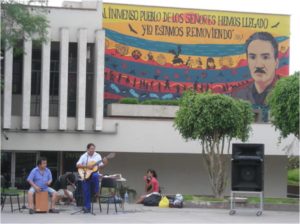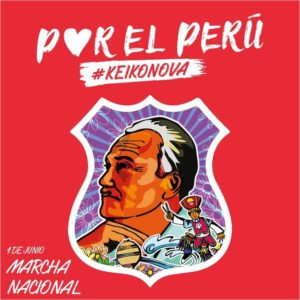By Raúl Valdivia-Murgueytio (Newcastle University)
I first encountered José María Arguedas’ photographs of Chimbote, a port city some 300 miles north of Lima, in an exhibition at the Casa de la Literatura Peruana in 2018. I was in Lima researching a photographic archive as part of my doctoral project on the photographic production of people living in deprived urban areas in the 1980s and 1990s. Most of these amateur photographers were second generation migrants whose parents had left their towns and villages in the Andes in search for a better life in the capital in the 1960s.
Seeing Arguedas’ pictures, which depict the lives of Andean migrants in Chimbote in the late 1960s, made me think about visuality in Peru in those years and to what extent the visual experience and sensibility of those photographed by Arguedas were informing the representational practices of the people whose photographs I was researching for my study. Could Arguedas’ pictures be another piece in that complex and multifaceted puzzle that is contemporary Peruvian society?
Finding out about Arguedas’ photographs was truly refreshing. I read most of his novels at school but had never come across these pictures before. In them, Arguedas registers the physical environment and social world he experienced in Chimbote, the setting of this last novel ‘El Zorro de Arriba y el Zorro de Abajo’ (‘The Fox from Up Above and the Fox from Down Below’) which was published posthumously in 1971.
The idea of curating these photographs was born out of a personal interest in engaging with this visual dimension of Arguedas’ creative output, which has received little attention. Permission to use the photographs displayed on the website was sought early in this process. I liaised directly (by email) with Arguedas’ widow and other members of the family in order to explain the purpose of the exhibition and get their authorisation. This was also an opportunity to find out more about Arguedas’ relationship with the camera and the nature of his photographic work.
One of the challenges in the making of ‘A Fox with a Camera’ exhibition, hereafter called AFWAC, was how to create a conversation between these pictures and the text in the novel. Moreover, I felt that it was important to consider the ‘sound’ of these images as well as their ‘visual reverberation’, which has been amplified in the context of the last elections in Peru.
The figure of Arguedas resonates powerfully with many Peruvians nowadays. Indeed, el tayta, who is often seen as a symbol of social justice and vindication of indigenous people, can be found in a range of visual materials circulating in the country. From murals (Figure 2) and political cartoons (Figure 3), to digital flyers calling for demonstrations (Figure 4) and placards waved by protesters on the streets, Arguedas is everywhere in Peru. AFWAC was curated against this social and political backdrop.
 |
 |
| Figure 2: Mural by unknown artist (Universidad Agraria) | Figure 3: Political cartoon by Carlos Tovar (‘La República’ newspaper) |
Originally conceived as a physical exhibition, AFWAC took on a virtual form due to the limitations imposed by the COVID-19 pandemic. Designing the exhibition website was the task of a final-year fine art student at Newcastle University whose support I was able to access through the university’s career service. The decision of going digital had many advantages, among them the possibility of reaching a wider audience outside London. Furthermore, a digital platform offered an alternative way of integrating image, sound and text. The online exhibition events also worked well in terms of generating a space for discussion among people based in different parts of the world (the recordings of these roundtable discussion are available on the exhibition Facebook page).
Another key aspect in the process of curating these photographs was their organisation and sequencing. My intention was to create different points of entry into this body of images, following three themes that emerge from the novel: migration, life in the barriadas and the fishing industry. These sequences are presented in a non-linear manner, thus allowing viewers to engage freely with the main narratives of the exhibition (and perhaps to create their own).
Each sequence begins with a short video in which water acts as a metaphor for the flow of people arriving to Chimbote, their ‘liquid lives’ and the immensity of an unknown future under accelerated modernisation. On a practical level, I selected these videos from a stock video site, bearing in mind the narrative I wanted to create in each sequence. I also chose the sounds and texts that accompany the images, so viewers can have an immersive experience.
The way I envisioned AFWAC was influenced by John Akomfrah’s three-channel video installation ‘The Unfinished Conversation’. This beautiful and moving piece focuses on the life of Jamaican-born academic Stuart Hall, for whom identity was ‘an ever-unfinished conversation’. This idea of identity as a process of becoming, rather than an essence, informed my curatorial approach to Arguedas’ photographs. In my view, these images are showing us new identities in the making in Peru in the late 1960s.
One final point about the making of AFWAC is that it aims to foster new lines of enquiry into the issues raised and/or evoked by the exhibition. In other words, the exhibition is not only an invitation to engage with Arguedas’ photographs in a multi-sensory manner, it is also asking the viewer to consider the conditions of possibility that made these images exist as they are in the first place. I argue that by attuning ourselves to the different discourses articulated in these pictures, we can develop a more critical understanding of Peruvian society today.
‘A Fox with a Camera’ virtual exhibition is available for visitors to see it in their own time. You can visit the exhibition here: https://afoxwithacamera.cargo.site/
Author
Raúl Valdivia-Murgueytio is research associate in the School of Education, Communication and Language Sciences at Newcastle University and an affiliate member of the Centre for Latin American and Caribbean Studies (CLACS) at the same university. Raúl is also a lecturer in Spanish at Nottingham Trent University.
Disclaimer
The views expressed in this article are the author’s own and do not necessarily represent the position of CLACS or the School of Advanced Study, University of London.



Recent Comments